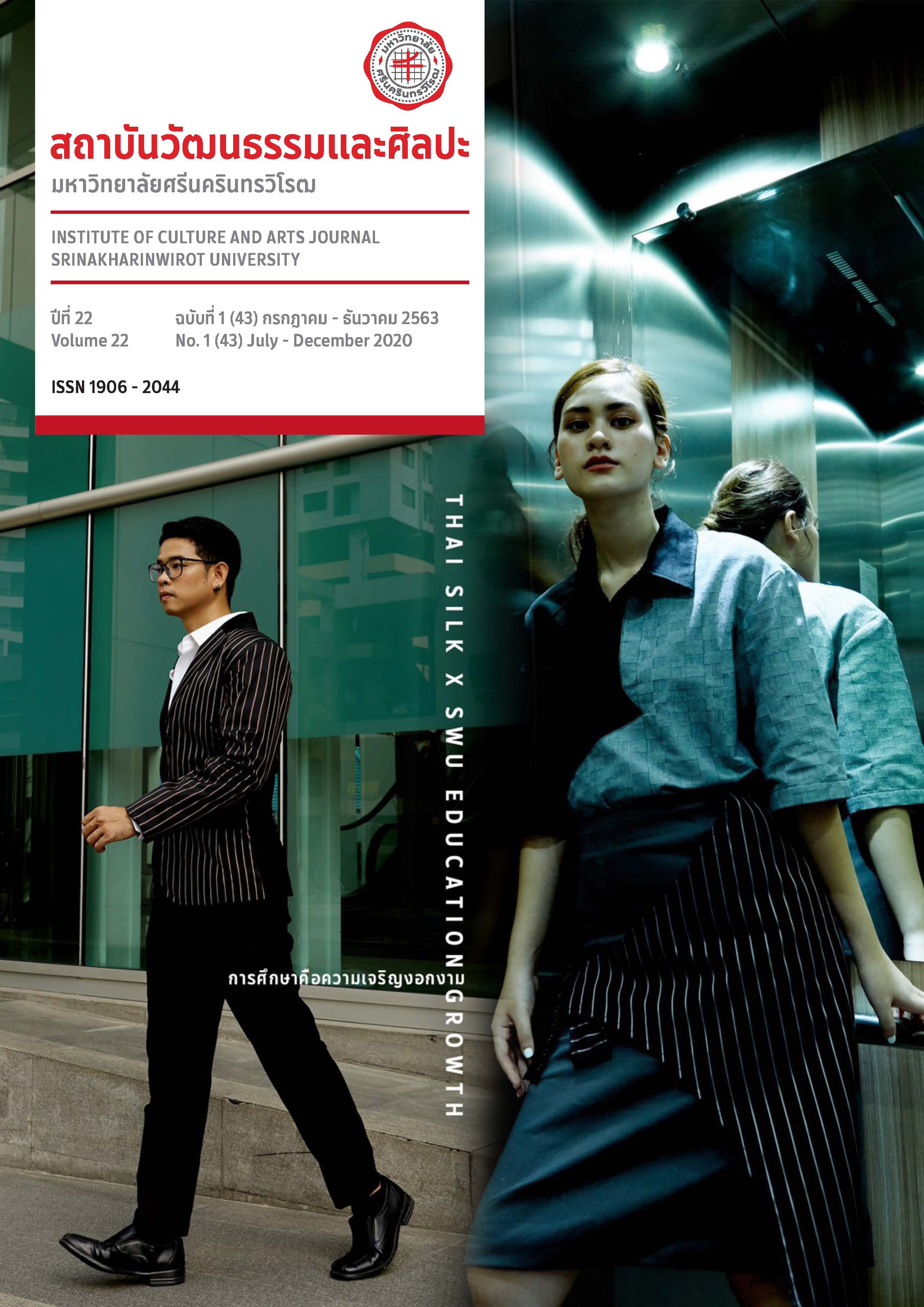นาฏศิลป์กับการประยุกต์อุปกรณ์ตามแนวคิดหลังสมัยใหม่
คำสำคัญ:
นาฏศิลป์แนวคิดหลังสมัยใหม่, นาฏศิลป์สร้างสรรค์, การประยุกต์อุปกรณ์บทคัดย่อ
การวิจัยนาฏศิลป์กับการประยุกต์อุปกรณ์ตามแนวคิดหลังสมัยใหม่ เพื่อสร้างสรรค์แนวทางการออกแบบลีลาในงานนาฏศิลป์สร้างสรรค์ โดยงานวิจัยในครั้งนี้มีวัตถุประสงค์เพื่อสร้างสรรค์แนวทางการออกแบบลีลาในงานนาฏศิลป์กับการประยุกต์อุปกรณ์ตามแนวคิดหลังสมัยใหม่เป็นการวิจัยเชิงสร้างสรรค์และการวิจัยเชิงคุณภาพ ซึ่งมีกรอบแนวคิดในการวิจัยจากการวิเคราะห์ข้อมูลองค์ความรู้ที่เกี่ยวข้อง เพื่อกำหนดทิศทางในงานวิจัยได้แก่ แนวคิดหลังสมัยใหม่ การประยุกต์อุปกรณ์ในงานนาฏศิลป์ การออกแบบงานนาฏศิลป์ และ สุนทรียศาสตร์ ผู้วิจัยได้กำหนดการวิเคราะห์ข้อมูลทางด้านวิจัยโดยมีการวิเคราะห์จำแนกตามองค์ประกอบด้วยกัน 8 องค์ประกอบ เพื่อที่สามารถวิเคราะห์ข้อมูลได้ครบถ้วนตามองค์ประกอบในการสร้างสรรค์ผลงานครั้งนี้ คือ แนวคิดการแสดง อุปกรณ์การแสดง การออกแบบลีลา นักแสดง เสียงประกอบการแสดง เครื่องแต่งกาย แสงในการแสดง และพื้นที่ในการแสดง เพื่อนำมาสรุปผลก่อนการนำเสนอผลงาน ตามลำดับ ผลการวิจัยจากการวิเคราะห์ตามองค์ประกอบด้วยกัน 8 องค์ประกอบพบว่า 1. แนวคิดการแสดงจากแนวนาฏศิลป์หลังสมัยใหม่ในช่วงการทดลอง (Experimental Dance) หรือ ช่วงเวลาในการออกแบบลีลา มาเป็นแนวคิดในการวิจัยครั้งนี้ 2.การออกแบบลีลาเกิดจากการวิเคราะห์และออกแบบลีลาจากการเคลื่อนไหวลีลาไปพร้อมกับอุปกรณ์ 3.อุปกรณ์การแสดง ผู้วิจัยได้นำอุปกรณ์เป็นตัวดำเนินการที่ค้นหาลีลาการเคลื่อนไหวในขณะที่ทดลองออกแบบลีลาไปพร้อมกับอุปกรณ์ โดยอุปกรณ์ในการแสดงครั้งนี้จะเป็นอุปกรณ์ที่มาจากสิ่งของทั่วไปที่สามารถพบเห็นได้ในชีวิตประจำวัน 4.นักแสดง ผู้วิจัยได้คัดเลือกจากผู้ที่มีคุณสมบัติ 1.ผู้ที่สามารถแสดงศักยภาพในการเคลื่อนไหวร่างกายไปกับอุปกรณ์ได้ 2. ผู้ที่มีไหวพริบที่จะแก้ไขสถานการณ์เฉพาะหน้าได้เป็นอย่างดี 3. ผู้ที่สามารถแสดงผลงานได้อย่างต่อเนื่องเพื่อให้การแสดงไม่สะดุดหรือติดขัด โดยผู้วิจัยได้ทดลองให้นิสิตมหาวิทยาลัยศรีนคริทรวิโรฒ คณะศิลปกรรมศาสตร์ เอกนาฏศิลป์สากล ชั้นปีที่ 3 จำนวน 20 คน มีนิสิตชายจำนวน 5 คน และนิสิตหญิงจำนวน 15 คน ได้ลองเคลื่อนไหวร่างกายไปกับอุปกรณ์ โดยสังเกตการณ์ว่านิสิตคนใดสามารถเล่นอุปกรณ์ในขณะที่เคลื่อนไหวร่างกายในลักษณะต่างๆ อาทิ การหมุน การกระโดด 5.เสียงประกอบการแสดง ผู้วิจัยได้แบ่งภาพรวมในกานำเสียงประกอบการแสดงออกเป็น 2 ช่วงการแสดง โดยช่วงที่หนึ่ง เสียงในการแสดงเกิดจากการเคลื่อนไหวร่างกายกับอุปกรณ์ทำให้เกิดเสียง และช่วงที่สองเป็นการใช้เสียงดนตรีมานำเสนอโดยมีจังหวะที่เร็วและช้าควบคู่กันไป 6. เครื่องแต่งกาย ผู้วิจัยจึงเน้นที่เครื่องแต่งกายในการแสดงต้องไม่เป็นอุปสรรคต่อการเล่นอุปกรณ์ของนักแสดง 7. แสงในการแสดง ผู้วิจัยได้ใช้เพียงแสงสีขาวและสีเหลือง เพื่อให้มีความสว่างทำให้นักแสดงสามารถมองเห็นอุปกรณ์ได้ชัดและผู้ชมสามารถเห็นภาพการแสดงได้อย่างสมบูรณ์ 8. พื้นที่ในการแสดง สถานที่ในการเผยแพร่งานวิจัยมีลักษณะกว้าง จำนวนนักแสดงสามารถแสดงศักยภาพได้อย่างอิสระ
ข้อสรุปจากการวิจัยครั้งนี้แสดงให้เห็นถึงแนวทางในการสร้างสรรค์ผลงานการแสดงนาฏศิลป์กับการประยุกต์อุปกรณ์ตามแนวคิดหลังสมัยใหม่ โดยการค้นหาลีลาที่เกิดขึ้นจากการด้นสดของนักแสดงกับอุปกรณ์ในช่วงการทดลอง (Experimental Dance) หรือ ช่วงเวลาในการออกแบบลีลา ทำเกิดรูปแบบการเคลื่อนไหวที่น่าสนใจ สามารถวิเคราะห์และค้นหาลีลานำมาร้อยเรียงกลายเป็นผลงานที่ไม่ต้องยึดติดแต่เพียงการเล่าเรื่อง หรือ ต้องมีเนื้อเรื่องแต่สามารถสร้างสรรค์ผลงานได้จากการนำอุปกรณ์มาเป็นสิ่งที่ค้นหาลีลาในการสร้างสรรค์และกลายมาเป็นแนวทางในการวิจัย เพื่อค้นหาแนวทางในการพัฒนากระบวนการสร้างสรรค์ผลงานให้หลากหลายและมีอิสระของความคิดสร้างสรรค์
Downloads
เอกสารอ้างอิง
ธรากร จันทนะสาโร. (2561). อาจารย์ประจำสาขาวิชานาฏศิลป์ คณะศิลปกรรมศาสตร์ มหาวิทยาลัยศรีนคริทรวิโรฒ. สัมภาษณ์โดยรักษ์สินี อัครศวะเมฆ. 15 เมษายน.
นราพงษ์ จรัสศรี. (2548). ประวัตินาฏยศิลป์ตะวันตก (พิมพ์ครั้งที่ 1). กรุงเทพฯ: สำนักพิมพ์แห่งจุฬาลงกรณ์มหาวิทยาลัย.
วิรุณ ตั้งเจริญ.(2547). ศิลปกรรมศาสตราจารย์: 60 ปี ศาสตราจารย์ ดร.วิรุณ ตั้งเจริญ (พิมพ์ครั้งที่ 1). กรุงเทพมหานคร: สันติสิริการพิมพ์.
ศิริมงคล นาฏยกุล. (2557). นาฏยศิลป์ตะวันตกปริทัศน์. ขอนแก่น: หจก.โรงพิมพ์คลังนานาวิทยา.
สมพร ฟูราจ. (2554). Mine: ศิลปะท่าทางและการเคลื่อนไหว. พิมพ์ครั้งที่ 1. กรุงเทพมหานคร: สำนักพิมพ์มหาวิทยาลัยธรรมศาสตร์.
ฤทธิรงค์ จิวากานนท์. (2557). ศิลปะการออกแบบเครื่องแต่งกายละครเวทีสมัยใหม่. กรุงเทพมหานคร: โครงการเผยแพร่ผลงาน วิชาการ คณะอักษรศาสตร์ จุฬาลงกรณ์มหาวิทยาลัย.
Ambrosio, N. (1997). Learning about dance (2nd.ed.). lowa: Kendall/Hunt.
Lihs, H. (2009). Appreciating dance: A guide to the world’s liveliest art (4th ed.). Canada: Princeton Book Company.
Mac Donald, C. J. (1991). Creative dance in elementary schools: A theoretical and Practical justification. Canadian Journal of Education, 16(4), 434-441.
Minton, S. C.(1997). Choreography: a basic approach using improvisation (2nd ed.). United States: Human Kinetic.
Smith,J.M.(1985).Dance Composition A practical Guide for Teacher(2nd ed.).London:A&C Black.
ดาวน์โหลด
เผยแพร่แล้ว
รูปแบบการอ้างอิง
ฉบับ
ประเภทบทความ
สัญญาอนุญาต
บทความทุกบทความที่ได้รับการตีพิมพ์ถือเป็นลิขสิทธิ์ของวารสารสถาบันวัฒนธรรมและศิลปะ มหาวิทยาลัยศรีนครินทรวิโรฒ



